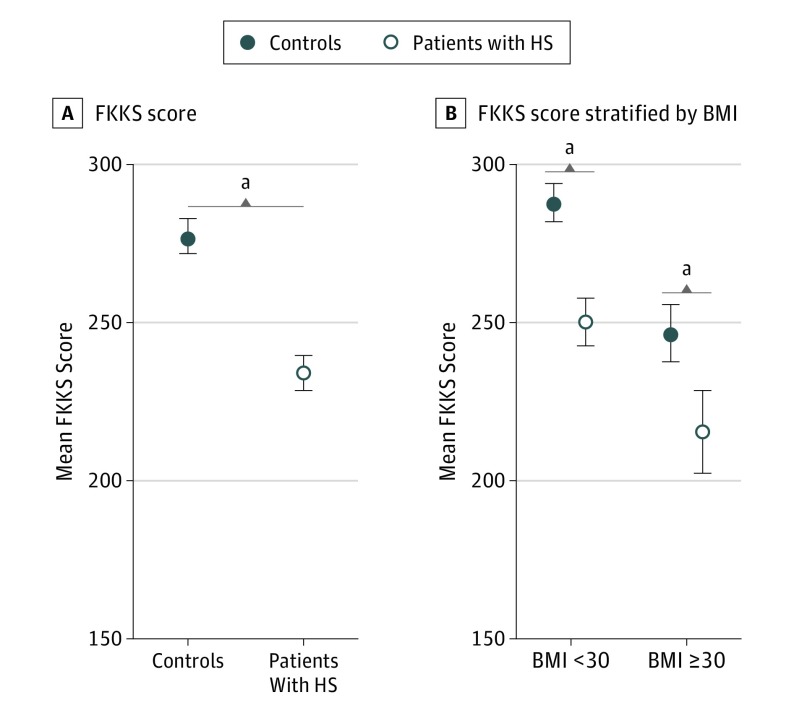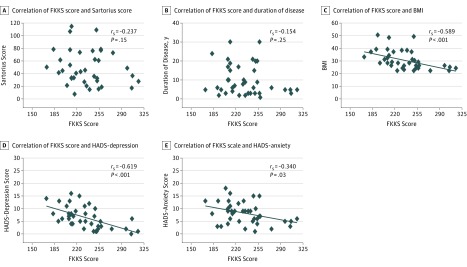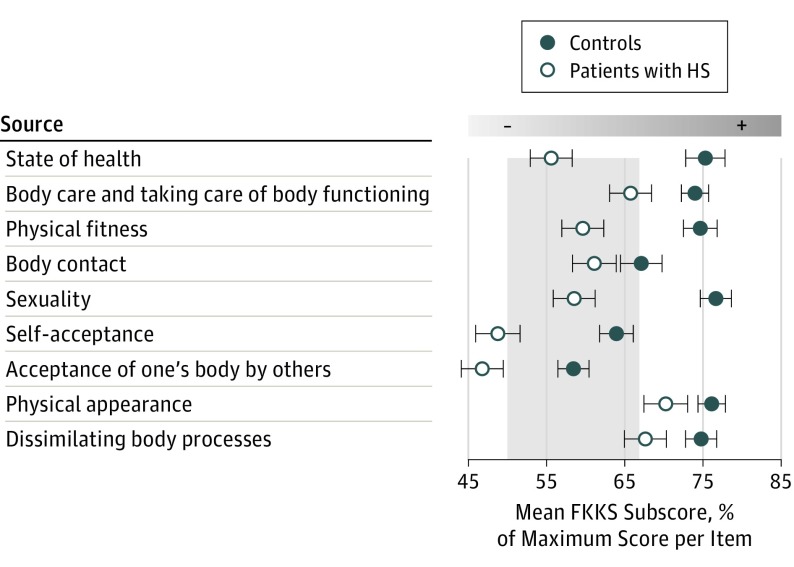This case-control study investigates whether body image is impaired in patients with hidradenitis suppurativa and whether disease severity, age at onset, disease duration, obesity, depression, and anxiety are linked to body image impairment.
Key Points
Questions
Because hidradenitis suppurativa is associated with severe impairment of quality of life and depression, is it also associated with decreased body image?
Findings
In this case-control study, the body image of 46 patients with hidradenitis suppurativa was significantly impaired compared with that of 41 healthy control individuals and was associated with depression and anxiety but not with the severity of the disease.
Meaning
Altered body image is another element of the psychosocial distress of patients with hidradenitis suppurativa that might be linked to depression and anxiety and thus could be used as an effective outcome measure.
Abstract
Importance
Hidradenitis suppurativa (HS) leads to disfigurement and painful eruptions in terminal hair follicles of the intertriginous skin, mainly of axillary, genitofemoral, and perianal sites. It is associated with an excessive impairment of quality of life, psychiatric disorders, and sexual distress. Body image impairment has been linked to depression and anxiety and has been described for some dermatologic disorders but has not yet been investigated in patients with HS.
Objectives
To investigate whether body image is diminished in patients with HS and whether disease severity, age at onset, disease duration, obesity, depression, and anxiety are linked to body image impairment.
Design, Setting, and Participants
This 12-month (August 1, 2009, to August 31, 2010) case-control study with a prospective, observational, cross-sectional design recruited 47 consecutive patients with HS entering a tertiary care center and 45 healthy control individuals matched for age, sex, and body mass index (BMI). One patient and 4 controls failed to complete the questionnaire and were excluded from the evaluation. Data analysis was performed from December 1, 2013, to February 15, 2014.
Main Outcomes and Measures
The Frankfurt Body Concept Scale (FKKS) and the Hospital Anxiety and Depression Scale (HADS) were given to patients and controls. Correlations among FKKS, HADS, and disease features were calculated.
Results
Of the 46 patients and 41 controls included in the evaluation (mean [SD] age, 35.6 [1.6] years; 40 [46%] male and 47 [54%] female), HS significantly reduced body image (mean FKKS score, 234.2 [5.4] in patients and 276.9 [5.7] in controls; P < .001), even when controlled for BMI. A correlation was found for the extent of body image disruption and BMI (r = −0.589; P < .001), HADS-depression score (r = −0.619; P < .001), and HADS-anxiety score (r = −0.340; P = .03). No association was found for the body image score and the severity of HS, age at onset of disease, and duration of disease. The body contact subscale score was the only subscale score that was not different between patients with HS and controls.
Conclusions and Relevance
Patients with HS have major body image impairment, which might lead to depression and anxiety, disorders that have been largely acknowledged in HS. This study identified another element of the psychosocial burden of patients with HS and reveals that body image could potentially be used as an outcome measure in future studies of HS.
Introduction
Hidradenitis suppurativa (HS) is a chronic inflammatory disease that affects the terminal hair follicles of the intertriginous skin, mainly of axillary, genitofemoral, and perianal sites. An estimated 1% of the general population has HS, with a higher prevalence of up to 4% in women. Typically, HS has its onset in young adulthood.
Hidradenitis suppurativa has a severe systemic effect and coincides with metabolic alterations, inflammatory bowel disease, and axial spondyloarthritis. In addition, HS is associated with a higher incidence of psychiatric disorders, such as psychoses, schizophrenia, bipolar disorders, depression, and anxiety. Furthermore, HS is known to be a highly distressing disease, causing a major impairment in quality of life, problems in sexual life, and significant pressure for patients at work.
Body image (BI), defined by Schilder as the image of our own body which we form in our mind, indicates a person’s awareness of his/her own appearance and his/her perception of how others see him/her. Body image develops during childhood and adolescence and undergoes constant changes. Body image dissatisfaction may result in feelings of shame, embarrassment, and anxiety and cause lack of self-confidence, depression, and social isolation.
Because HS leads to disfigurement of mainly the axillary, genitofemoral, and perianal sites, we expected alterations of the BI in these patients. New knowledge on this subject might help us to better understand the psychological issues of patients with HS.
Methods
We conducted a case-control study in patients with HS seen consecutively in the Department of Dermatology, University Hospital Charité, Berlin, Germany, from August 1, 2009, to August 31, 2010. Forty-seven patients (27 women, 20 men) with HS and 45 controls (23 women, 22 men) were recruited. One patient and 4 controls failed to complete the questionnaire and were excluded from the evaluation. Data analysis was performed from December 1, 2013, to February 15, 2014. Patients with HS were compared with healthy controls matched for age, sex, and body mass index (BMI, calculated as weight in kilograms divided by height in meters squared) who were selected from the population. Patients and controls were informed verbally and in writing about the study’s objective and their rights, including anonymity and voluntariness. They were enrolled after written informed consent had been witnessed and recorded. All data were processed anonymized. This study was approved by the ethics committee of the University Hospital Charité.
Demographic characteristics and details of the course of the disease (eg, age at onset, region at onset, duration of the disease) were recorded for each patient. Disease severity was assessed by the Sartorius score. After clinical evaluation, patients and controls were asked to fill out the Frankfurt Body Concept Scale (FKKS) and Hospital Anxiety and Depression Scale (HADS). The FKKS is a self-rating instrument that assesses different aspects of the BI of a person. It consists of 9 subscales with a total of 64 items (eTable 1 in the Supplement). The level of agreement with each statement is rated on a 6-point scale. Higher scores signify a better BI. The HADS is a self-assessment questionnaire that identifies anxious and depressive symptoms in the past week. The questionnaire contains 7 questions on depression and anxiety, each with a 4-level response option. Higher values indicate a greater level of depression or anxiety.
Statistical calculations were performed using SPSS, version 18.0 (SPSS Inc). P < .05 was considered to be statistically significant.
Results
A total of 46 patients and 41 controls were included in the evaluation (mean [SD] age, 35.6 [1.6] years; 40 [46%] male and 47 [54%] female). There were no significant differences in age, height, weight, and BMI between the groups (eTable 2 in the Supplement). Patients with HS had a significant reduction in the FKKS sum score compared with the control group (mean FKKS score, 234.2 [5.4] in patients and 276.9 [5.7] in controls; P < .001) (Figure 1A). No association was found between the FKKS sum score and disease severity (Figure 2A), duration of disease (Figure 2B), or age at onset of disease. However, a significant negative correlation was found between the FKKS sum score and patients’ BMI (Figure 2C). We stratified patients and controls into 2 BMI groups (<30 and ≥30). Within both BMI groups, the FKKS sum score was significantly reduced in patients with HS compared with controls (Figure 1B). Correlating the FKKS sum score with the HADS-depression and the HADS-anxiety score, we found that a lower BI was significantly associated with a higher grade of depression (Figure 2D) and higher level of anxiety (Figure 2E).
Figure 1. Frankfurt Body Concept Scale (FKKS) Scores in Patients With Hidradenitis Suppurativa (HS) and Control Individuals.
For information about the FKKS sum score, see the Methods section. Error bars indicate SD. BMI indicates body mass index (calculated as weight in kilograms divided by height in meters squared).
aP < .001 (Mann-Whitney test).
Figure 2. Correlation of the Frankfurt Body Concept Scale (FKKS) Sum Score and Disease Severity, Body Mass Index (BMI), and Psychiatric Disorders in Patients With Hidradenitis Suppurativa.
Spearman rank correlation analysis was used. For information on the FKKS score and Hospital Anxiety and Depression Scale (HADS), see the Methods section. BMI was calculated as weight in kilograms divided by height in meters squared.
Analyzing the FKKS subscales, we detected significant differences between patients with HS and controls in all subscale scores except for the body contact subscale (eTable 3 in the Supplement). The subscale scores that were valued to be negative in patients with HS according to the interpretation by Bullinger were self-acceptance and acceptance of one’s body by others (Figure 3).
Figure 3. Frankfurt Body Concept Scale (FKKS) Subscores in Patients With Hidradenitis Suppurativa (HS) and Control Individuals.
The gray shading indicates a neutral (as opposed to negative or positive) score on each of the FKKS subscales according to the interpretation by Bullinger. Plus sign indicates positive; minus sign, negative. Error bars indicate SD.
Assuming that the subscales health and physical fitness are indicators for the subjective health of patients, we examined whether there was a correlation between these subscales and the severity of the disease. The Sartorius score showed a significant correlation with these 2 subscales and with the subscale self-acceptance of one’s body but not with the remaining 6 subscales (eTable 4 in the Supplement).
Discussion
Previous studies established that patients with HS frequently have depression, sexual distress, and a reduced quality of life. In addition, we found a severely impaired BI in patients with HS compared with healthy controls. Altered BI has been found in patients with a few dermatologic diseases, such as psoriasis, atopic dermatitis, and acne. Using the same test instrument, we found that the BI in patients with HS was impaired even more than in patients with atopic dermatitis.
A previous study suggested that BI alterations are increased by physical and functional changes of chronic disease states. Thus, we expected the BI score to correlate with disease severity and duration. However, in patients with HS in our study, the overall FKKS scale showed no significant association with either one. Only the subscales state of health and physical fitness, reflecting the physical aspects of BI, were associated with the severity of disease. This association suggests that patients with HS have a realistic awareness of their physical impairment. However, they simultaneously experience a profound, disease severity–independent influence of other BI aspects. Because BI is established in adolescence and HS can have an early onset during puberty, we were surprised not to find an association between age at onset of disease and BI impairment. Nevertheless, our patient population might be too small to draw a conclusion.
Eating disorders are well recognized to have a major association with BI; eminent examples are bulimia or anorexia nervosa. In addition, obesity has been recognized to correlate with BI dissatisfaction. Accordingly, we found a significant association between patients’ BMI and the FKKS sum score. However, consideration of HS and control subgroups with different BMIs revealed diminished BI in patients with HS. Thus, we conclude that HS and BMI are independent factors that influence body concept in patients with HS.
Poor BI has been shown previously to be related to depression, social anxiety, and poor self-esteem, illustrating the effect of BI on psychological disturbances and aspects of the quality of life. In agreement with these observations, the BI impairment found in patients with HS correlated significantly with depression and anxiety as measured by the HADS. It is probable that improving the BI in patients with HS has a positive influence on patients’ depression and anxiety also.
Analyzing the FKKS subscales, we found significant differences between patients with HS and controls in all subscales apart from the body contact subscale. Examples of items on this subscale are, “I like it if somebody embraces me” and “I like it if somebody strokes my head.” We assumed that patients with HS would not want to be touched by others; however, we were wrong. This finding fits the experience in clinical practice when patients with HS often appear for checkups accompanied by their partner, family members, or close friends, who are frequently involved in taking care of their wounds and changing wound dressings.
The patients with HS had remarkably low self-acceptance and acceptance by others scores compared with patients with atopic dermatitis or patients with facial prostheses after tumor surgery. Examples of items on these subscales are, “I would like to exchange parts of my body,” “I am not very attractive to others,” and “If somebody criticizes my appearance, I feel worthless.” These comments emphasize the insecurity that the disease instigates in patients.
Limitations
The main limitation of this study is the small sample size.
Conclusions
Overall, our study demonstrates an additional aspect of the psychosocial burden of HS. According to our results, the disease is often accompanied by poor BI, particularly in patients with coexisting obesity. In addition, the severity of disease is associated with the physical aspects of BI even if there is no association with the overall BI score. Therefore, patients’ psychological well-being may benefit from efficient treatment of the disease. We recommend that the BI scale be used as an outcome measure for future treatment studies because it is connected to patients’ depression and anxiety.
eTable 1. The Frankfurt Body Concept Scale (FKKS) Consists of 9 Different Subscales With a Total of 64 Items
eTable 2. Demographic Characteristics of Patients With HS and Controls
eTable 3. Frankfurt Body Concept Scale (FKKS) in Patients With HS and Controls
eTable 4. Correlation of the Frankfurt Body Concept Scale (FKKS) With the Severity of Disease (Sartorius Score) in Patients With HS
References
- 1.Jemec GB, Heidenheim M, Nielsen NH. The prevalence of hidradenitis suppurativa and its potential precursor lesions. J Am Acad Dermatol. 1996;35(2, pt 1):191-194. [DOI] [PubMed] [Google Scholar]
- 2.Shavit E, Dreiher J, Freud T, Halevy S, Vinker S, Cohen AD. Psychiatric comorbidities in 3207 patients with hidradenitis suppurativa. J Eur Acad Dermatol Venereol. 2015;29(2):371-376. [DOI] [PubMed] [Google Scholar]
- 3.Matusiak Ł, Bieniek A, Szepietowski JC. Hidradenitis suppurativa markedly decreases quality of life and professional activity. J Am Acad Dermatol. 2010;62(4):706-708, 708.e1. [DOI] [PubMed] [Google Scholar]
- 4.Kurek A, Peters EM, Chanwangpong A, Sabat R, Sterry W, Schneider-Burrus S. Profound disturbances of sexual health in patients with acne inversa. J Am Acad Dermatol. 2012;67(3):422-428, 428.e1. [DOI] [PubMed] [Google Scholar]
- 5.Schilder P, ed. The Image and Appearance of the Human Body. Oxford, England: Kegan Paul; 1935. [Google Scholar]
- 6.Tomas-Aragones L, Marron SE. Body image and body dysmorphic concerns. Acta Derm Venereol. 2016;96(217):47-50. [DOI] [PubMed] [Google Scholar]
- 7.Noles SW, Cash TF, Winstead BA. Body image, physical attractiveness, and depression. J Consult Clin Psychol. 1985;53(1):88-94. [DOI] [PubMed] [Google Scholar]
- 8.Sartorius K, Lapins J, Emtestam L, Jemec GB. Suggestions for uniform outcome variables when reporting treatment effects in hidradenitis suppurativa. Br J Dermatol. 2003;149(1):211-213. [DOI] [PubMed] [Google Scholar]
- 9.Deusinger IM. Measurement of change in self-concept with the Frankfurt self-concept scales [in German]. Z Gerontol. 1982;15(1):42-45. [PubMed] [Google Scholar]
- 10.Zigmond AS, Snaith RP. The hospital anxiety and depression scale. Acta Psychiatr Scand. 1983;67(6):361-370. [DOI] [PubMed] [Google Scholar]
- 11.Bullinger M. Health related quality of life and subjective health: overview of the status of research for new evaluation criteria in medicine [in German]. Psychother Psychosom Med Psychol. 1997;47(3-4):76-91. [PubMed] [Google Scholar]
- 12.Lohmann K. Untersuchung über Selbstkonzepte von Patienten mit Neurodermitis [diploma thesis]. Frankfurt/Main, Germany: JW Goethe-Universität; 1992. [Google Scholar]
- 13.Pruzinsky T. Enhancing quality of life in medical populations: a vision for body image assessment and rehabilitation as standards of care. Body Image. 2004;1(1):71-81. [DOI] [PubMed] [Google Scholar]
- 14.Caspi A, Amiaz R, Davidson N, et al. Computerized assessment of body image in anorexia nervosa and bulimia nervosa: comparison with standardized body image assessment tool. Arch Womens Ment Health. 2017;20(1):139-147. [DOI] [PubMed] [Google Scholar]
- 15.Weinberger NA, Kersting A, Riedel-Heller SG, Luck-Sikorski C. Body dissatisfaction in individuals with obesity compared to normal-weight individuals: a systematic review and meta-analysis. Obes Facts. 2016;9(6):424-441. [DOI] [PMC free article] [PubMed] [Google Scholar]
Associated Data
This section collects any data citations, data availability statements, or supplementary materials included in this article.
Supplementary Materials
eTable 1. The Frankfurt Body Concept Scale (FKKS) Consists of 9 Different Subscales With a Total of 64 Items
eTable 2. Demographic Characteristics of Patients With HS and Controls
eTable 3. Frankfurt Body Concept Scale (FKKS) in Patients With HS and Controls
eTable 4. Correlation of the Frankfurt Body Concept Scale (FKKS) With the Severity of Disease (Sartorius Score) in Patients With HS





